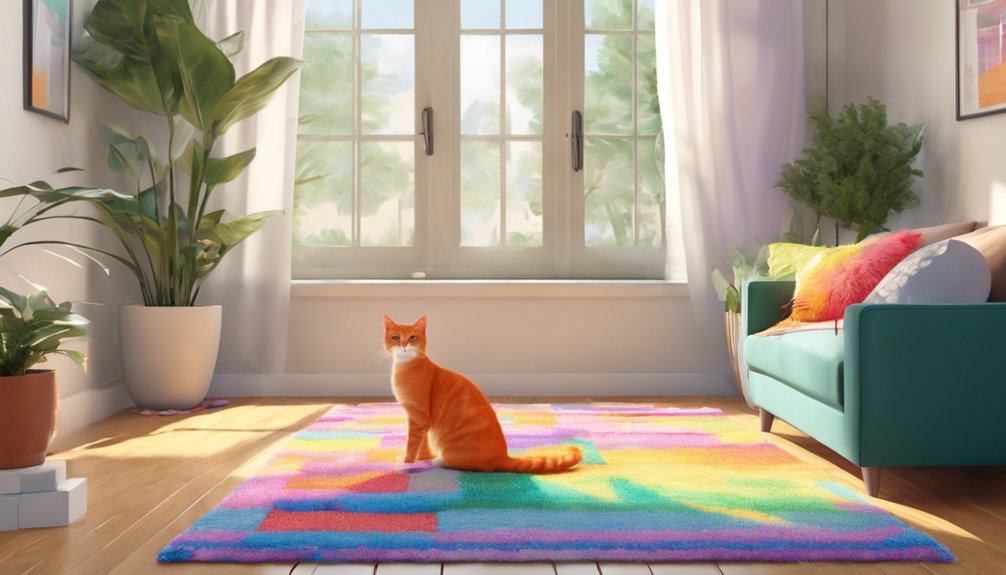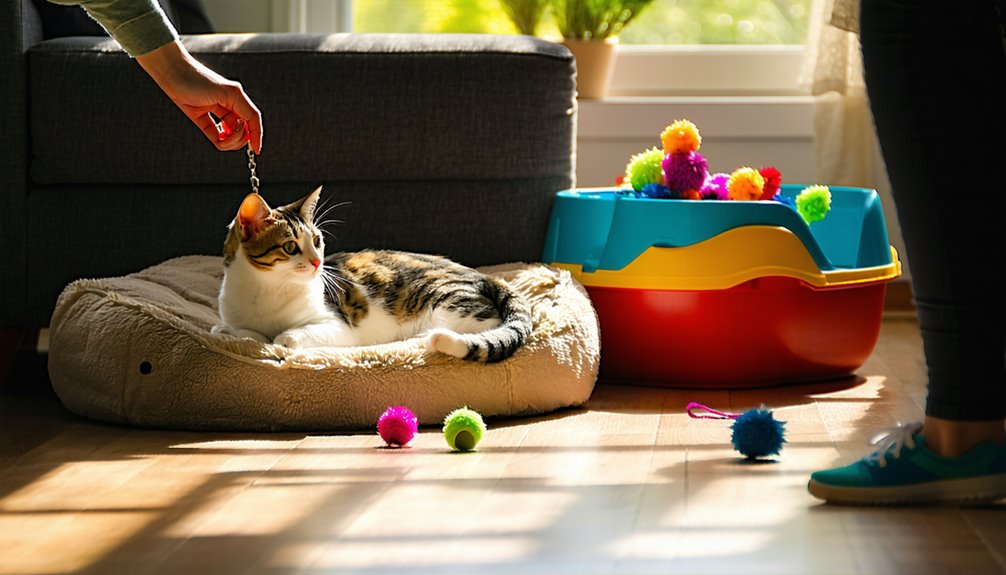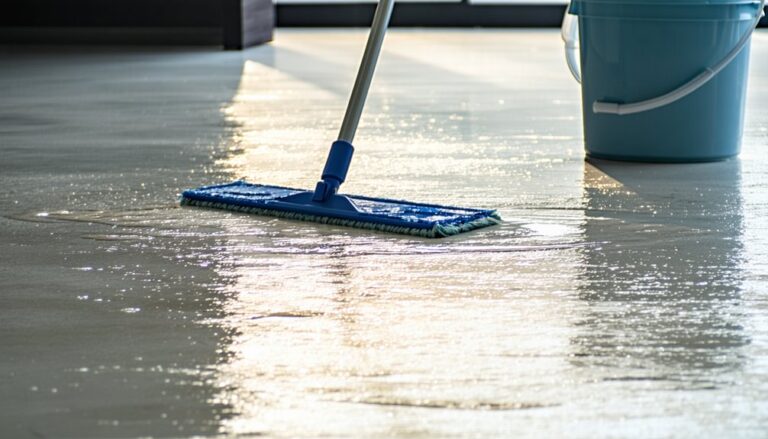To stop your cat from pooping on the floor, start by identifying any behavioral triggers or health issues. Confirm your cat's litter box is clean, located in a quiet area, and large enough for comfort. Providing multiple boxes can also help, especially if you have more than one cat. Experiment with different types of litter to find what your cat prefers. Use positive reinforcement by praising and treating your cat when they use the litter box. Consulting a veterinarian is crucial to rule out any medical problems. You'll find more tips to create a supportive environment for your furry friend.
Identify the Underlying Causes

When your cat starts pooping on the piso, it can be frustrating and concerning, especially if you're unsure why it's happening. To address this issue, you need to identify the underlying causes. Start by observing any behavioral triggers that might be influencing your cat's actions. Changes in their routine, stress from new pets, or even loud noises can lead to this behavior. Additionally, consider environmental factors like the cleanliness of the litter box or its location. Cats are sensitive creatures, and a box that's too dirty or in a high-traffic area can deter them from using it. By understanding these triggers and factors, you can create a more conducive environment for your feline friend, helping them feel secure and comfortable.
Check for Health Issues
Checking for health issues is essential if your cat is pooping on the floor. Changes in cat behavior can signify underlying health problems, so it's important to pay attention to any unusual signs. Look for health symptoms that might indicate a medical issue:
- Excessive litter box use
- Blood in the stool
- Vomiting or diarrhea
- Weight loss or gain
- Changes in appetite or drinking habits
If you notice any of these symptoms, don't hesitate to consult your veterinarian. They can diagnose any potential health issues and provide appropriate treatment. Remember, your cat's well-being is paramount, and addressing these concerns early can help maintain their freedom and happiness in your home.
Evaluate Litter Box Setup

To effectively address your cat's litter box issues, it's important to evaluate the setup. Consider the location, size, and type of box you're using, as well as how clean and well-maintained it is. Making these adjustments can greatly improve your cat's bathroom experience and help prevent accidents on the floor.
Litter Box Location
Where you place your cat's litter box can greatly impact their bathroom habits. Guaranteeing a suitable location can promote better use and reduce accidents. You want to balance litter box privacy with litter box accessibility, so your cat feels secure yet can reach it easily.
Consider these tips:
- Place the litter box in a quiet area, away from high traffic.
- Make sure it's easily accessible, especially for older cats.
- Avoid placing it near food and water bowls.
- Keep it away from noisy appliances like washing machines.
- Provide multiple boxes if you have several cats to reduce territorial issues.
Box Size and Type
Choosing the right size and type of litter box is essential for encouraging your cat to use it consistently. Start by considering litter box dimensions; it should be at least one and a half times the length of your cat from nose to tail. A box that's too small can lead to discomfort and avoidance. Next, think about litter box materials. Plastic boxes are common and easy to clean, while those made of heavier materials can prevent tipping and spilling. Some cats prefer covered boxes for privacy, while others like open designs for accessibility. Ultimately, your cat's preferences are paramount, so observe what they seem to favor, and adjust your setup accordingly to create a welcoming environment.
Cleanliness and Maintenance
A clean litter box is essential for encouraging your cat to use it regularly. Neglecting litter box cleanliness can lead to poor cat hygiene and unwanted accidents on the floor. To maintain a fresh environment, consider these key practices:
- Scoop daily to remove waste
- Change litter weekly to prevent odors
- Wash the box with mild soap monthly
- Place the box in a quiet, accessible location
- Use unscented litter to avoid overwhelming your cat
Choose the Right Cat Litter
Choosing the right cat litter is essential for encouraging your cat to use the litter box consistently. You'll want to contemplate the types of litter available, the texture and granule size that feels comfortable for your cat, and options for scent control that keep your home fresh. Making the right choice can greatly reduce accidents and improve your cat's bathroom experience.
Types of Cat Litter
When you evaluate the importance of litter in your cat's bathroom habits, selecting the right type can considerably impact their behavior and comfort. Here are some popular types of cat litter to evaluate:
- Clumping Litter: Easy to clean, it forms solid clumps for quick removal.
- Biodegradable Options: Made from materials like corn or wheat, they're eco-friendly and safe.
- Crystal Litter: Absorbs moisture and controls odors effectively.
- Non-Clumping Litter: Typically made from clay, it absorbs liquid but requires more frequent changes.
- Recycled Paper Litter: Gentle on paws and highly absorbent, ideal for sensitive cats.
Texture and Granule Size
Finding the right texture and granule size for your cat's litter can make a significant difference in their bathroom habits. Cats often prefer finer granules that mimic natural soil, providing comfort under their paws. If the litter texture is too rough or too large, your cat might avoid using it altogether, leading to unwanted accidents.
Experiment with different granule sizes to see what your cat enjoys most. A medium grain might strike a perfect balance between comfort and clumping ability. Additionally, consider your cat's age and health; senior cats may benefit from softer textures. Ultimately, a litter that caters to their preferences can help encourage proper use of the litter box, fostering a happier, healthier environment for both you and your feline friend.
Scent Control Options
To guarantee your cat uses the litter box consistently, it's essential to take into account the scent control options available in cat litter. Choosing the right litter can make a significant difference in your cat's bathroom habits. Look for products that incorporate scent neutralizers to combat odors effectively. Additionally, think about using pheromone sprays to create a calming environment that encourages your cat to feel secure while using the box.
Here are some scent control options to reflect on:
- Clumping litter with scent neutralizers
- Natural, unscented options
- Crystal litter that absorbs moisture
- Clay-based litter with added fragrances
- Pheromone sprays designed for litter boxes
Maintain a Clean Environment

Maintaining a clean environment is essential for your cat's well-being and can greatly reduce the likelihood of accidents. Regularly clean surfaces where your cat frequents, ensuring that areas are free of debris and waste. Cats are sensitive to odors, so thorough odor elimination is vital; use enzymatic cleaners specifically designed for pet messes to effectively neutralize smells. It's also important to keep the litter box clean, scooping daily and changing the litter regularly. Providing your cat with a tidy space to do their business will encourage them to use the litter box consistently. By prioritizing cleanliness, you not only create a comfortable environment for your feline friend but also foster a healthier and happier home for both of you.
Reduce Stress Factors
Since a cat's environment can heavily influence their behavior, reducing stress factors is essential in preventing accidents like pooping on the floor. By focusing on environmental enrichment and careful behavioral observation, you can create a more calming atmosphere for your feline friend. Here are some effective strategies:
- Provide hiding spots and cozy resting areas
- Offer engaging toys and interactive playtime
- Maintain a consistent routine for feeding and litter box cleaning
- Minimize loud noises and sudden changes in the environment
- Introduce calming aids, like pheromone diffusers or soft music
Provide Multiple Litter Boxes

To help prevent your cat from pooping on the floor, consider providing multiple litter boxes. The right placement, quantity, and type of litter boxes can make a significant difference in your cat's bathroom habits. By ensuring your cat has easy access to suitable options, you're promoting a more comfortable and stress-free environment.
Litter Box Placement
Providing multiple litter boxes can greatly improve your cat's bathroom habits, especially if you have more than one feline in your home. To enhance litter box accessibility, consider these placement tips:
- Quiet corners: Choose locations away from loud appliances or busy areas.
- Avoid high traffic zones: Make sure the boxes aren't in pathways where cats may feel threatened.
- Separate spaces: Place boxes in different rooms to give each cat options.
- Accessible heights: Make certain boxes are easy to enter, especially for older or less agile cats.
- Minimal distractions: Keep the area free from toys and other items that could divert their attention.
Litter Box Quantity
Having the right number of litter boxes can greatly impact your cat's willingness to use them. In multi-cat households, it's crucial to provide at least one litter box per cat, plus one extra. This setup accommodates individual litter box preferences, ensuring each cat has access to a clean space without feeling threatened or stressed. Cats can be territorial, so having multiple boxes can reduce competition and anxiety. By placing these boxes in various locations throughout your home, you give your cats the freedom to choose where they feel most comfortable. Regularly cleaning each box also helps maintain their appeal. Remember, a happy cat is more likely to use the litter box, keeping your floors clean and your home harmonious.
Litter Box Types
When it comes to litter box types, choosing the right one can make a significant difference in your cat's habits. Offering a variety of options can help your feline feel comfortable and secure. Here are some types to evaluate:
- Self cleaning boxes: These automate the cleanup process, making it easier for you and more appealing for your cat.
- Covered boxes: They provide privacy, which some cats prefer, and can help contain odors.
- Open boxes: Great for cats who like easy access and visibility.
- Large boxes: Ideal for bigger breeds or multiple cats, ensuring ample space.
- Eco-friendly options: Made from sustainable materials, they cater to eco-conscious pet owners.
Experimenting with different styles can lead to a happier, healthier cat.
Train Your Cat Effectively
Training your cat effectively requires patience and understanding, as each feline has its own personality and learning pace. Start by observing your cat's behavior to identify patterns and triggers. This insight will help you tailor your training techniques to fit their unique needs. Consistency is key—establish a routine that incorporates regular litter box access and encourages positive habits. Use gentle cues and guidance to reinforce desired behaviors, ensuring your cat feels secure during the process. Avoid punishment, as it can lead to fear and anxiety, which may worsen undesirable behaviors. Instead, focus on creating a supportive environment that fosters trust, allowing your cat to thrive and learn at their own pace while reducing accidents on the floor.
Use Positive Reinforcement

Positive reinforcement is a powerful tool in shaping your cat's behaviors, especially when it comes to litter box habits. By implementing reward systems, you can enhance your cat's behavioral motivation to use the litter box consistently. Here are some effective strategies:
- Treats: Offer a favorite treat immediately after they use the litter box.
- Praise: Use a cheerful tone to praise your cat when they successfully go in the litter box.
- Playtime: Engage in a fun play session as a reward for appropriate behavior.
- Consistency: Maintain a regular schedule for feeding and litter box cleaning to encourage habits.
- Safe Space: Verify the litter box is in a quiet, accessible area to promote comfort.
With patience and positive reinforcement, your cat can learn to avoid accidents.
Consult a Veterinarian
If your cat continues to poop on the floor despite your best efforts, it may be time to consult a veterinarian. A vet can help identify any underlying medical issues that could be causing this behavior. Sometimes, health problems manifest as inappropriate elimination, so it's crucial to rule these out first. Additionally, your vet can discuss potential behavioral triggers that might be affecting your cat, like stress or changes in the household. They may also recommend dietary changes to improve your cat's digestion and overall gut health. Remember, addressing these issues with a professional can lead to a happier, healthier cat and restore peace in your home. Don't hesitate to seek help; your cat deserves it.
Preguntas frecuentes
Can Certain Cat Breeds Be More Prone to Litter Box Issues?
Certain cat breeds can indeed be more prone to litter box issues, often due to their unique breed behavior and litter box preferences. For example, some breeds may prefer specific litter textures or box types, impacting their willingness to use it. It's important to understand your cat's needs and preferences, as this awareness can help you create a more accommodating environment, ensuring their comfort and promoting proper litter box habits.
How Do I Clean Cat Poop Stains Effectively?
To clean cat poop stains effectively, start by removing any solid waste. Then, use a mixture of warm water and mild detergent for poop cleaning. Apply it to the stain, gently blotting with a clean cloth. For stubborn stains, consider using an enzymatic cleaner designed for stain removal, which breaks down organic matter. Rinse the area thoroughly and dry it well to prevent lingering odors. It's crucial to maintain a fresh, clean environment for both you and your cat.
Can Changes in Diet Affect Litter Box Behavior?
Absolutely, changes in diet can greatly affect your cat's litter box behavior. If you're considering dietary adjustments, increasing fiber intake might help regulate their digestion. Cats may struggle with constipation or diarrhea if their diet lacks proper nutrients. By providing a balanced diet, you can promote healthy bowel movements and overall well-being. It's important to monitor any changes closely and consult your vet if you notice persistent issues. Your cat's comfort is key!
Is It Normal for Cats to Occasionally Poop Outside the Litter Box?
It's not uncommon for cats to occasionally stray from their litter box, like wandering stars in a night sky. While this behavior can signal underlying behavioral issues, one or two mishaps aren't typically cause for alarm. Cats may be responding to stress, health concerns, or simply a preference for a different spot. Observing their habits can help you understand their needs, ensuring their comfort and happiness in your shared space.
What Are the Signs of Litter Box Aversion in Cats?
When it comes to litter box aversion, you might notice several signs indicating your cat's discomfort. Look for changes in their litter box preferences, such as avoiding it or showing signs of stress when near it. Behavioral triggers can include a dirty box, uncomfortable location, or type of litter. If your cat is meowing excessively or eliminating outside the box, they could be communicating their dissatisfaction. Understanding these signs is key to helping them feel secure.




